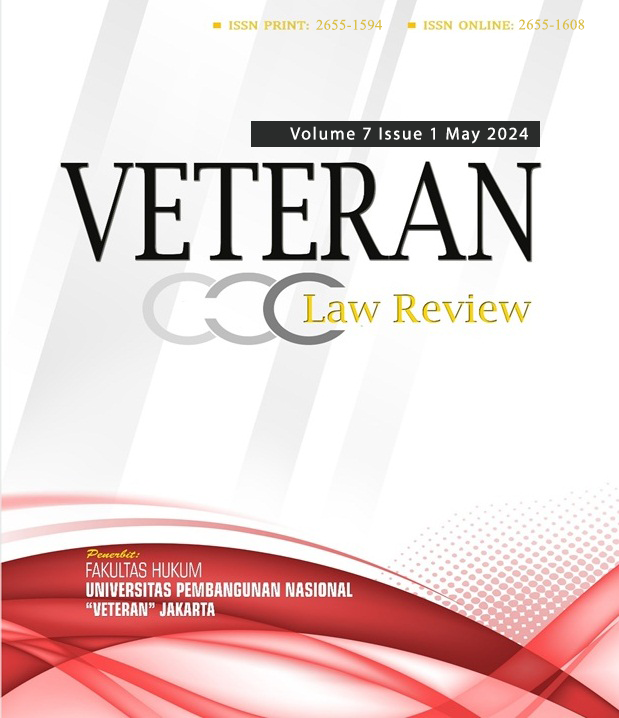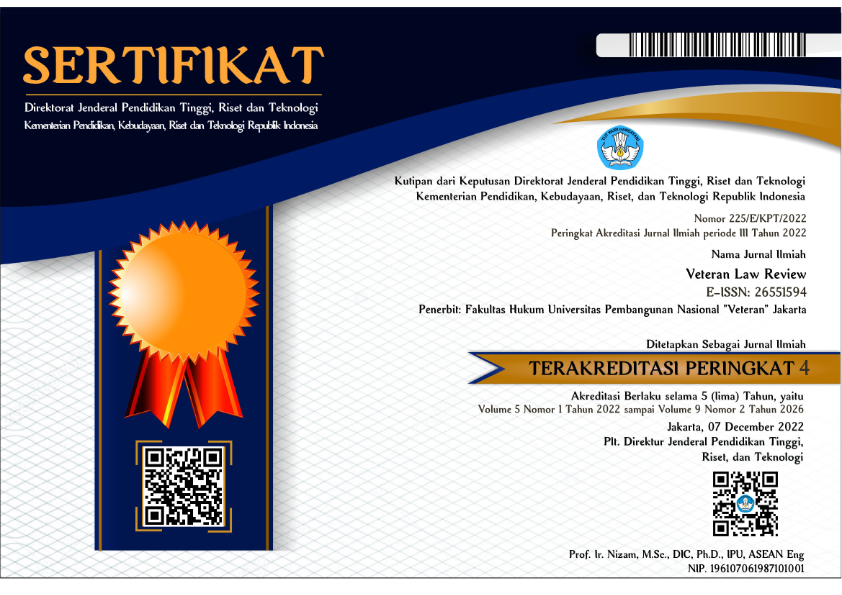Conditional Release Policy to Resolve Overcapacity in Correctional Institution
DOI:
https://doi.org/10.35586/velrev.v7i1.6409Keywords:
Conditional Release Policy; Overcapacity; Correctional Institution;Abstract
As a place to rehabilitate convicts, correctional institutions foster convicts to become better person with a good character, independence, skill, discipline and awareness of the law. This is in accordance with the function of the correctional system which is a system of treatment of convicts, which follows the renewal of prison sentences based on Pancasila and the principles of humanity. The problem is, currently the majority of correctional institutions in Indonesia have over capacity problems. This over capacity has the potential to become various problems. An example is the monitoring and rehabilitation of convicts that doesn't work properly, and even spends a lot of budget on operational costs. The problem of overcapacity which certainly has an impact on various aspects of life in prisons or detention centers which tends to be dysfunctional towards the achievement of correctional goals. The conditional release policy for convicts who prioritizes the principles of rehabilitating can be used as a solution in solving various problems and accommodating legal needs in society. The establishment of this arrangement is also part of an effort to harmonize regulations in order to create a correctional system that is oriented towards protecting human rights in the 1945 Constitution of the Republic of Indonesia.
Downloads
References
Angkasa. (2010). Overcapacity Narapidana di Lembaga Pemasyarkataan, Jurnal Dinamikaa Hukum, Vol 10 Nomor 3. 214-221.
Ardiansyah, Ary & Subroto, Mitro, (2022). Implementasi Pemberian Pembebasan Bersyarat Kepada Narapidana Pidana Umum Pada Masa Pandemi Covid-19 di Lembaga Pemasyarakatan Kelas IIA Bengkulu, Jurnal Pendidikan Kewarganegaraan Undiksha Vol. 10 No. 2. 461-475.
Databoks.katadata.co.id, “Penghuni Lapas dan Rutan Kelebihan Kapasitas 109% pada September 2022”, Juni, 10, 2023. Available Online, https://databoks.katadata.co.id/datapublish/2022/09/23/penghuni-lapas-dan-rutan-kelebihan-kapasitas-109-pada-september-2022
Firmansyah, (2019). Pemenuhan Pelayanan Kesehatan dan Konsumsi Bagi Narapidana di Lapas dan Rutan. Jurnal Magister Hukum Udayana (Udayana Master Law Journal) Online, Volume 8 Number 3. 332-448.
Hamzah, Andi. (1986). Sistem Pidana di Indonesia: Dari Retribusi ke Reformasi, in Jimly Asshiddiqie, Pembaharuan Hukum, Jakarta: Pradnya Paramita.
Indra, Mexsasai. (2016). Dampak Kelebihan Kapasitas Warga Binaan Di Lembaga Pemasyarakatan Klas II A Pekanbaru Dikaitkan Pemenuhan Hak-Hak Warga Binaan, JOM Fakultas Hukum Universitas Riau, Volume III Nomor 2.
Lamintang, P.A.F. & Lamintang, Theo, Hukum Penitensier Indonesia, Jakarta, Sinar Grafika, 2010.
Mudzakir. (2008). Perencanaan Pembangunan Hukum Nasional bidang Hukum Pidana Dan Sistem Pemidanaan (Politik Hukum Dan Pemidanaan). Jakarta: BPHN.
Muladi. (1995). Kapita Selekta Hukum Pidana, Semarang: Badan Penerbit Universitas Diponegoro.
Nasional.Kompas.com, “jumlah napi bertambah biaya makancapai Rp.1,7 Triliun”, Juni, 10, 2023, Available Online https:// nasional. kompas. com/ read/2018/12/27/15413471/
Panjaitan, Petrus Irwan Panjaitan & Simorangkir, Pandapotan. (1995) Lembaga Pemasyarakatan Dalam Prespektif Sistem Peradilan Pidana Penjara, Jakarta: Pustaka Sinar Harapan.
Ramadhani, Indah Noor & Subroto, Ramadhani. (2022) Implementasi Pembebasan Bersyarat Terhadap Narapidana di Lembaga Pemasyarakatan. Jurnal Politik dan Sosial Kemasyarakatan. Vol 14 No 2.
Rizaldi, Rafi. (2020). Over Kapasitas di Lembaga Pemasyarakatan Kelas II A Cikarang, Faktor Penyebab dan Upaya Penanggulangan Dampak. Justitia: Jurnal Ilmu Hukum dan Humaniora. Vol. 7 No. 3. 628-640.
The United Nations Office on Drugs and Crime (UNODC), Panduan tentang strategi untuk mengurangi kepadatan dalam penjara, PBB, New York, 2013.
Widayati, Lidya Suryani. (2016). Rehabilitasi Narapidana dalam Overcrowded Lembaga Pemasyarakatan, Jurnal Negara Hukum, Vol.3, No. 2. 201-226.
Downloads
Published
How to Cite
Issue
Section
License
Copyright (c) 2024 Veteran Law Review

This work is licensed under a Creative Commons Attribution-ShareAlike 4.0 International License.
Copyright (c) 2022 Veteran Law Review Journal
Veteran Law Review © 2022 by Faculty of Law Universitas Pembangunan Nasional "Veteran" Jakarta is licensed under Creative Commons Attribution 4.0 International

1. License
The non-commercial use of the article will be governed by the Creative Commons Attribution license as currently displayed on Creative Commons Attribution 4.0 International.
2. Author(s)' Warranties
The author warrants that the article is original, written by the stated author(s), has not been published before, contains no unlawful statements, does not infringe the rights of others, is subject to copyright that is vested exclusively in the author, and free of any third party rights, and that any necessary written permissions to quote from other sources have been obtained by the author(s).
3. User/Public Rights
VELREV's spirit is to disseminate articles published are as free as possible. Under the Creative Commons Attribution-ShareAlike 4.0 International License. VELREV permits users to copy, distribute, display, and perform the work for non-commercial purposes only. Users will also need to attribute authors and VELREV to distributing works in the journal and other media of publications.
4. Rights of Authors
Authors retain all their rights to the published works, such as (but not limited to) the following rights;
- Reproduce the work
- Prepare derivative works based upon the work
- Distribute copies of the work
- Perform the work publicly
- Display the work publicly
- Copyright and other proprietary rights relating to the article, such as patent rights,
- The right to self-archive the article,
- The right to enter into separate, additional contractual arrangements for the non-exclusive distribution of the article's published version (e.g., post it to an institutional repository or publish it in a book), with an acknowledgement of its initial publication in this journal (Veteran Law Review).
5. Co-Authorship
If the article was jointly prepared by more than one author, any author submitting the manuscript warrants that he/she has been authorized by all co-authors to be agreed on this copyright and license notice (agreement) on their behalf, and agrees to inform his/her co-authors of the terms of this policy. VELREV will not be held liable for anything that may arise due to the author's internal dispute. VELREV will only communicate with the corresponding author.
6. Royalties
Being an open accessed journal and disseminating articles for free under the Creative Commons license term mentioned, author(s) are aware that VELREV entitles the author(s) to no royalties or other fees.
7. Miscellaneous
VELREV will publish the article (or have it published) in the journal if the article’s editorial process is successfully completed. JOSI's editors may modify the article to a style of punctuation, spelling, capitalization, referencing, and usage that deems appropriate. The author acknowledges that the article may be published so that it will be publicly accessible and such access will be free of charge for the readers as mentioned in point 3.


















